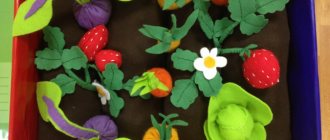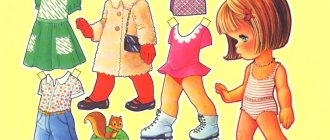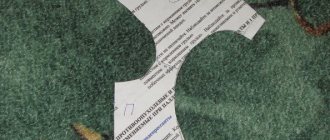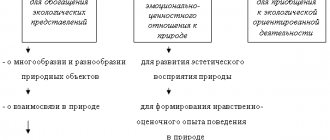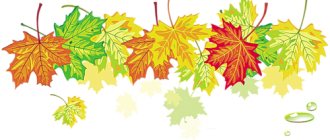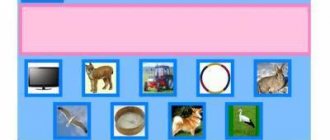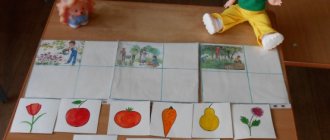Didactic game: “Autumn Adventure”, for children 4 - 7 years old
Author:Lyanguzova Olga Zhanovna
Position:
teacher - speech therapist
Place of work:
MKDOU No. 18, Miass, Chelyabinsk region
Purpose of the material:
the game can be used by specialists in working with preschool children aged 4 - 7 years, including for children with disabilities.
Equipment:
1 playing field, 9 pictures of leaves, 9 pictures of trees.
Goal:
development of observation, visual attention and memory
Objectives:
1. Activate children’s knowledge on the topic: “Autumn. Trees in autumn"
2. Develop the ability to form relative adjectives, develop basic mental processes.
3. Develop the ability to obey the rules of the game and play in a group of peers.
Form of organization:
individual or subgroup (2-3 people)
Preliminary work:
familiarization with the image of leaves and trees.
Progress of the game:
1 option
In front of the children there is a playing field of 9 sectors. Each sector contains 3 pictures depicting autumn leaves (chestnut leaf, oak leaf, willow leaf, aspen leaf, linden leaf, poplar leaf, rowan leaf, maple leaf, birch leaf).
The first move is determined by the counting rhyme:
"One two three four five.
We will collect leaves.
If you find a leaf,
I went first and played.”
If 3 children are playing, then each is given 3 pictures depicting single leaves.
The first player examines his leaves and the first sector on the playing field, if he finds among his leaves a similar one on the field, then he closes the sector with it and correctly names the leaf (chestnut leaf). Then considers the next sector. If the required sheet is not available, then the turn passes to the next player.
If there are 2 children playing, then we distribute 3 pictures to each and put 3 next to each other in a pile (with their shirts up) - “on the path.” The game is similar, but if the required sheet is not available, then it must be taken from the path. Only after this the turn passes to the other player.
The players' task is to get rid of their cards as quickly as possible.
The adult monitors the correct completion of the task and the formation of relative adjectives, correcting if necessary. If the child does not form the word correctly, he must stop and repeat the adjective correctly 3 to 5 times (maple, maple, maple)
Option 2
The game is played similarly to the previous one, with the only difference, instead of leaves, children are offered with images of trees. Thus, the task becomes more difficult, since children need to determine which tree the leaf comes from. In this version of the game, the child points to a leaf and introduces a relative adjective into the sentence: “A willow leaf from a willow tree.”
Making the game:
Word.
The picture material is taken from the Internet (links from sources are located below).
In the search engine we type the word CLIPART (picture on a transparent background) and the name of the picture. Select the required image, copy and paste it into the document. To remove the background, perform the following steps: WORK WITH THE DRAWING - REPAINT - SET A TRANSPARENT BACKGROUND.
So that the picture can easily move on the sheet, you need to click on the right mouse button, select OBJECT FORMAT - TEXT WRAP - BEFORE TEXT. The entire material can be downloaded from the “Download” link.
Didactic games and exercises on the lexical topic “Trees. Bushes"
1. “The fourth extra”
(name the extra object, explain your choice using the words
“because”
)
- oak, poplar, aspen, lilac
- roots, branches, nest, trunk
- early, golden, late, frosty (sub. gr.)
- aspen, birch, oak, rosehip (under gr.)
- birch, rowan, maple, carrot (sub. gr.)
2. “Call it in one word”
,
“Name it in two words” (choose a generalizing word)
- oak, birch, aspen, maple - this is ...
- rosehip, lilac, currant, rowan - this
- birch, linden, aspen, maple - these are... trees (sub. gr.)
- spruce and pine are... trees (under gr.)
3. “What are the same and how are they different from each other?”
- spruce and pine (under gr.)
- rowan and currant (under gr.)
- tree and bush (under gr.)
- acorns grow on birch trees
- birch is a coniferous tree (sub. gr.)
- under the oak tree the children collected cones (under the gr.)
- the trees swayed and a strong wind blew (under gr.)
- buds appear on the trees (under gr.)
5. "Finish the sentence"
— in our yard there is a slender...
- under the oak tree we found a lot...
- the leaves turn yellow and quietly fall on...
7. "Name the parts of the whole"
- a tree has... (trunk, branches, crown, roots, leaves, fruits)
- What will a tree without branches ?
-... a forest without trees ?
- What is more in the forest: trees or leaves ?
9. “Pick a pair word”
Summary of the lesson on modeling “Autumn trees and bushes” for the middle group “Autumn trees and bushes” for the middle group. Section: Modeling Topic: “Autumn trees and bushes.” Purpose: Roll the balls between your palms and flatten them.
Summary of the lesson on modeling “Autumn trees and bushes” for the middle group “Autumn trees and bushes” for the middle group. Section: Modeling Topic: “Autumn trees and bushes.” Purpose: Roll the balls between your palms and flatten them.
Didactic and educational games on the topic “Trees” Awakening love for the world around us and cultivating respect for living nature must begin at an early age. Kids very much.
Calendar and thematic planning of the week “Trees. Bushes in spring" in the first junior group. Topic of the week: "Trees. Bushes in the spring” Goal: to form children’s ideas about trees, bushes in their immediate environment, their growth and development.
Summary of educational activities on the lexical topic “Trees” for children 5–6 years old with mental retardation Purpose: To clarify children’s knowledge about trees and their structure through an application. Objectives: 1. To consolidate children’s ideas about species diversity.
Presentation on the lexical topic “Trees” for children of senior preschool age Dear colleagues! I bring to your attention a slide presentation on the lexical topic “Trees” for children of senior preschool age. This one.
Educational electronic development - multimedia library. Development of a dictionary on the lexical topic “Forest. Trees. Shrubs" Focus: Activation of vocabulary. Prerequisites: Enrichment of the material and technical base and development environment of the group. Type: Educational - electronic.
Source
Trees (4 extra)
Description of the presentation by individual slides:
Slide description:
Speech therapist lessons The fourth wheel
Slide description:
Slide description:
Slide description:
Slide description:
Slide description:
Slide description:
Slide description:
Slide description:
Slide description:
Slide description:
Slide description:
Slide description:
Slide description:
Slide description:
Slide description:
Slide description:
If you believe that material violates copyright or for some other reason should be removed from the site, you can leave a complaint about the material.
Refresher course
Occupational Safety and Health
Professional retraining course
Library, bibliographic and information knowledge in the pedagogical process
Professional retraining course
Occupational Safety and Health
We are looking for teachers to join the Infourok team
Find material for any lesson by indicating your subject (category), class, textbook and topic:
You can also select the type of material:
general information
International Distance Olympiad Autumn 2021
Similar materials
Using the DragandDrop macro in the same presentation with triggers
Unusual computer peripherals
Loop statements in the Pascal ABC programming environment
Internet technologies in education
The amount of information as a measure of reducing knowledge uncertainty
Characteristics of the Information Society
Expanded form of the number. Converting a number from any number system to decimal
Windows Workflow Foundation 4.0
Didn't find what you were looking for?
Use the search in our database of 5319503 materials.
You might be interested in these courses:
Leave your comment
Log in to ask questions.
Didactic games "Trees" in the middle group
Games intended for the middle age group continue to introduce preschoolers to the signs and characteristics of different trees, foster curiosity, broaden their horizons, develop speech skills and the ability to think logically.
What grows on what?
The presenter begins the phrase, and the players logically continue:
Make up a picture
For the game, prepare pictures depicting trees familiar to preschoolers, cut them into several arbitrary parts. Hand out the cut images to the children and ask them to put the parts of the picture together into a single whole. Having completed the task, the child carefully examines the picture, says what plant he sees, and describes it. For example: “This is oak. He's big and strong. This is a forest tree. There are acorns hanging on it.”
Guess by description
The presenter names a list of signs, and the children try to guess what plant they are talking about:
Say an adjective
The presenter says the name of the tree, and the players take turns calling the defining adjective:
Good or bad
Have the players split into two groups. The first in line should name everything that benefits the trees. For example, watering, sun, rain, fertilizer, bees, heat. The latter call what is harmful to plants. For example, insects, fire, cold, frost, heat, drought. It is important that children explain their opinions in detail.
Didactic games “Trees” in the senior group
In the older group, preschoolers learn to distinguish, describe, classify, their ideas about the world around them expand, and speech skills develop.
Tell me about the leaf
The game teaches how to compose complex sentences; preschoolers' understanding of colors and shapes expands. For the activity, prepare dried leaves of different types of trees familiar to the children. Or print realistic images. Each student takes turns choosing the piece of paper that he likes more than the others and tries to describe it in detail.
Find a tree
It is better to play the game in a park where there are many different types of flora familiar to preschoolers. Children look at the plants around them, while listening carefully to the teacher. And he talks about the tree without naming it. Based on the description they hear, children must guess what plant they are talking about. For example, here is a description of the rowan: “A slender tree with long and narrow leaves, collected together in several pieces. In autumn, berry clusters form on the branches. The berries are small and red; bullfinches love to feast on them.”
I am a tree
Each player takes turns standing in front of his comrades, using gestures and body movements to depict the tree and what is happening to it. The other players guess what their friend is trying to show. For example, when imitating an oak tree, a child demonstrates that he is strong, spreads his legs, sticks out his chest, and makes sounds that imitate the rustling of leaves in the wind, the chirping of birds on the branches. When depicting a willow, the player makes a sad face, imitates crying, and limply lowers his hands.
What's extra?
The game teaches you to classify plants according to key characteristics. For the lesson, make cards, each of which should depict 4 types of trees, one of which belongs to another category.
Players look at the images one by one, identify the odd plant, and select a unifying category for the rest. If the player makes a mistake, the right to move is transferred to the next child. The one who correctly identified the extra tree gets a point. The winner is the one who scores the most points.
Here are examples for the game:
Fly to me, leaf
For active play, you need dried fallen leaves of different types and silhouette views of the same leaves. Players receive silhouettes one at a time. The teacher stands at the other end of the room and shows the dried leaves to the children. For example, he shows a maple leaf and calls: “Fly to me, maple leaf.” The player, who sees the corresponding outline, runs up to the teacher and talks about the features characteristic of the tree to which the demonstrated leaf belongs.
The game can be complicated by not naming the type of plant, but simply saying: “Fly a leaf to me.” Then the child, who has discovered the corresponding contour, must himself determine the species of the tree, then talk about it.
Unlimited access to classes with online tutors
More profitable than paying for each lesson separately
The Ministry of Education is working on a unified approach to the prevention of deviant behavior in children
Reading time: 1 minute
At the new “Numbers Lesson,” schoolchildren will be told about game development
Reading time: 1 minute
Popova proposed changing the school biology curriculum
Reading time: 1 minute
The Ministry of Education is developing an educational minimum for teacher training
Reading time: 2 minutes
In Yakutia, schoolchildren were sent to distance learning due to frost
Reading time: 1 minute
Teachers are offered 1.5 million rubles to move to Zlatoust
Reading time: 1 minute
Gift certificates
Responsibility for resolving any controversial issues regarding the materials themselves and their contents is taken by the users who posted the material on the site. However, the site administration is ready to provide all possible support in resolving any issues related to the work and content of the site. If you notice that materials are being used illegally on this site, please notify the site administration using the feedback form.
All materials posted on the site were created by the authors of the site or posted by users of the site and are presented on the site for informational purposes only. Copyrights for materials belong to their legal authors. Partial or complete copying of site materials without written permission from the site administration is prohibited! The opinion of the administration may not coincide with the point of view of the authors.
Source
